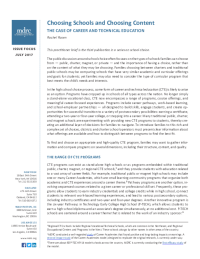Choosing Schools and Choosing Content
The Case of Career and Technical Education

This practitioner brief is the third publication in a series on school choice.
The public discussion around school choice often focuses on the types of schools families can choose from — public, charter, magnet, or private — and the importance of having a choice, rather than on the content of what they may be choosing. Families choosing between charters and traditional public schools may be comparing schools that have very similar academic and curricular offerings and goals for students; yet families may also need to consider the type of curricular program that best meets the child’s needs and interests.
In the high school choice process, some form of career and technical education (CTE) is likely to arise as an option. Programs have cropped up in schools of all types across the nation. No longer simply a stand-alone vocational class, CTE now encompasses a range of programs, course offerings, and meaningful career-focused experiences. Programs include career pathways, work-based learning, and school-employer partnerships — all designed to build skills, engage students, and create opportunities for successful transition to a variety of postsecondary possibilities: earning a certificate, attending a two-year or four-year college, or stepping into a career. Many traditional public, charter, and magnet schools are experimenting with providing new CTE programs to students, thereby creating an additional layer of decisions for families to navigate. To introduce families to this rich and complex set of choices, districts and charter school operators must present clear information about what offerings are available and how to distinguish between programs to find the best fit.
To find and choose an appropriate and high-quality CTE program, families may want to gather information and compare programs on several dimensions, including their structure, content, and quality.
The Range of CTE Programs
CTE programs can exist as stand-alone high schools or as programs embedded within traditional public, charter, magnet, or regional CTE schools,[1] and they provide students with education related to a vast array of career fields. For example, traditional public or magnet high schools may include one or many Career Academies, which are small learning-community programs that organize both academic and CTE experiences around a career theme.[2] Pathway programs are another option, involving sequenced courses related to a given career or professional skill set. Frequently, these programs allow students to earn industry credentials and college credits while in high school, connect students to relevant work-based learning experiences, and lead to various postsecondary options, including industry certificates and two-year and four-year degrees. Another innovative program is the six-year Pathways in Technology Early College High School (P-TECH), which allows students to earn a high school diploma and an associate’s degree simultaneously, at no additional cost. P-TECH schools are centered around a career theme that is related to the work of an industry sponsor.[3]
Families should understand that in some schools, all students are engaged in CTE, while in others only a subset of students participate. Programs like Career Academies, CTE charters, and regional CTE schools may have separate application processes, which may or may not be aligned with the district’s overall choice process.
Career Content
Across the different types of CTE schools and programs, the content varies widely — the federal government has defined 16 different career clusters, or groups of related jobs, which involve about 80 career pathways, as described above. Career clusters and pathways are in fields as varied as law and justice, finance, information technology, digital arts and media, and architecture and construction. The pathways that schools offer may be related to local industries or to programs at area colleges, both of which may work with schools to provide opportunities and training beyond high school.
Program Quality
In CTE’s evolution from vocational education classes into something dynamic and multifaceted, a key principle has been strong links between high school education and postsecondary opportunities through the earning of industry certificates, work-based learning experiences connected to local industry, and pathways that can continue into both careers and two-year and four-year colleges. Many schools and districts have eliminated classes and pathways that do not lead to sustainable opportunities beyond high school and have worked to enhance and develop those that do. Such improvements include integrating rigorous CTE and academic course work, structuring CTE courses that build on one another, and ensuring that classes are taught by certified CTE teachers. These indications of quality are important considerations for families in the choice process.
CTE and School Choice Architecture
In the previous brief in this series, MDRC outlined the three levels of action families need to take as they move through the school choice process. The variety of CTE school and program types, career content, and quality discussed here illustrates the complexity of the choices families face in finding the best match for their students.
Engage: The first action level is for families to engage with the specific district choice process and timing. Schools and districts can help families at this level by clearly outlining the differences between CTE and other options — especially CTE programs and schools with separate application processes.
Search: The second level of action involves gathering information. Districts can help families form a choice set by providing information about the available CTE options, including the benefits of various CTE curricula, the learning experiences embedded in each option, and the different postsecondary and career opportunities.
Match: The final level requires families to find schools and programs that match their students’ interests and aptitude. Districts and schools can help by facilitating comparisons on a variety of dimensions, such as opportunities to earn an industry credential or college credits while in high school, and by indicating how locally available jobs align with different pathways.
As it continues to evolve and grow, CTE may be one of the driving factors in how families make high school choices. Ensuring that families have salient information related to the wide variety of CTE options should be a priority. Increasing families’ ability to understand differences between schools and programs, as well as between expected college and career opportunities, is likely to increase positive matches between students and schools.
[1] Regional CTE schools include Regional Vocational Technical Schools, which are common in the Northeast, and Regional Occupational Centers and Programs in the West. These schools also go by other names in other areas of the country.
[2] MDRC conducted a well-regarded study of Career Academies that found positive and long-lasting impacts on earnings. A second impact study of the Career Academies model, designed to replicate the original research, is currently under way.
[3] There are about 60 P-TECH 9-14 model schools across the country. MDRC is currently conducting the first efficacy study of the model.






